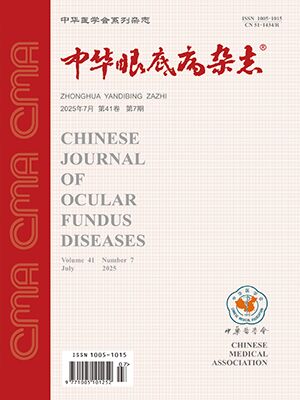| 1. |
Antonetti DA, Klein R, Gardner TW. Diabetic retinopathy[J]. N Engl J Med, 2012, 366(13): 1227-1239. DOI: 10.1056/NEJMra1005073.
|
| 2. |
陈长征, 许阿敏. 提升超广角荧光素眼底血管造影技术应用水平, 深化周边眼底特征观察及临床意义研究[J]. 中华眼底病杂志, 2017, 33(1): 7-9. DOI: 10.3760/cma.j.issn.1005-1015.2017.01.003.Chen CZ, Xu AM. Improve our understanding of ocular fundus diseases with ultra-wide-field fluorescein angiography[J]. Chin J Ocul Fundus Dis, 2017, 33(1): 7-9. DOI: 10.3760/cma.j.issn.1005-1015.2017.01.003.
|
| 3. |
Singer M, Tan CS, Bell D, et al. Area of peripheral retinal nonperfusion and treatment response in branch and central retinal vein occlusion[J]. Retina, 2014, 34(9): 1736-1742. DOI: 10.1097/IAE.0000000000000148.
|
| 4. |
Nicholson L, Vazquez-Alfageme C, Patrao NV, et al. Retinal nonperfusion in the posterior pole is associated with increased risk of neovascularization in central retinal vein occlusion[J]. Am J Ophthalmol, 2017, 182(10): 118-125. DOI: 10.1016/j.ajo.2017.07.015.
|
| 5. |
Fan W, Wang K, Ghasemi Falavarjani K, et al. Distribution of nonperfusion area on ultra-widefield fluorescein angiography in eyes with diabetic macular edema: DAVE study[J]. Am J Ophthalmol, 2017, 180(8): 110-116. DOI: 10.1016/j.ajo.2017.05.024.
|
| 6. |
中华医学会眼科学会眼底病学组. 我国糖尿病视网膜病变临床诊疗指南(2014年)[J]. 中华眼科杂志, 2014, 50(11): 851-865. DOI: 10.3760/cma.j.issn.0412-4081.2014.11.014.Fundus Ophthalmology Group of Chinese Medical Association Ophthalmology Society. The clinical diagnosis and treatment guidelines for diabetic retinopathy in China (2014)[J]. Chin J Ophthalmol, 2014, 50(11): 851-865. DOI: 10.3760/cma.j.issn.0412-4081.2014.11.014.
|
| 7. |
Fan W, Nittala MG, Velaga SB, et al. Distribution of nonperfusion and neovascularization on ultrawide-field fluorescein angiography in proliferative diabetic retinopathy (RECOVERY Study): report 1[J]. Am J Ophthalmol, 2019, 206(10): 154-160. DOI: 10.1016/j.ajo.2019.04.023.
|
| 8. |
Wang W, Lo ACY. Diabetic retinopathy: pathophysiology and treatments[J/OL]. Int J Mol Sci, 2018, 19(6): 1816[2018-06-20]. https://pubmed.ncbi.nlm.nih.gov/29925789/. DOI: 10.3390/ijms19061816.
|
| 9. |
Niki T, Muraoka K, Shimizu K. Distribution of capillary nonperfusion in early-stage diabetic retinopathy[J]. Ophthalmology, 1984, 91(12): 1431-1439. DOI: 10.1016/s0161-6420(84)34126-4.
|
| 10. |
许阿敏, 陈长征, 易佐慧子, 等. 糖尿病视网膜病变超广角荧光素眼底血管造影检查与标准7视野检查结果的对比分析[J]. 中华眼底病杂志, 2017, 33(1): 23-26. DOI: 10.3760/cma.j.issn.1005-1015.2017.01.007.Xu AM, Chen CZ, Yi ZHZ, et al. Comparative analysis of ultra-wide-field fluorescein angiography and early treatment diabetic retinopathy study 7 standard field photography in diabetic retinopathy[J]. Chin J Ocul Fundus Dis, 2017, 33(1): 23-26. DOI: 10.3760/cma.j.issn.1005-1015.2017.01.007.
|
| 11. |
Nicholson L, Ramu J, Chan EW, et al. Retinal nonperfusion characteristics on ultra-widefield angiography in eyes with severe nonproliferative diabetic retinopathy and proliferative diabetic retinopathy[J]. JAMA Ophthalmol, 2019, 137(6): 626-631. DOI: 10.1001/jamaophthalmol.2019.0440.
|
| 12. |
Lange J, Hadziahmetovic M, Zhang J, et al. Region-specific ischemia, neovascularization and macular oedema in treatment-naïve proliferative diabetic retinopathy[J]. Clin Exp Ophthalmol, 2018, 46(7): 757-766. DOI: 10.1111/ceo.13168.
|
| 13. |
Akiba J, Arzabe CW, Trempe CL. Posterior vitreous detachment and neovascularization in diabetic retinopathy[J]. Ophthalmology, 1990, 97(7): 889-891. DOI: 10.1016/s0161-6420(90)32486-7.
|
| 14. |
Antaki F, Coussa RG, Mikhail M, et al. The prognostic value of peripheral retinal nonperfusion in diabetic retinopathy using ultra-widefield fluorescein angiography[J]. Graefe's Arch Clin Exp Ophthalmol, 2020, 258(12): 2681-2690. DOI: 10.1007/s00417-020-04847-w.
|
| 15. |
Kristinsson JK, Gottfredsdóttir MS, Stefánsson E. Retinal vessel dilatation and elongation precedes diabetic macular oedema[J]. Br J Ophthalmol, 1997, 81(4): 274-278. DOI: 10.1136/bjo.81.4.274.
|
| 16. |
Curcio CA, Sloan KR, Kalina RE, et al. Human photoreceptor topography[J]. J Comp Neurol, 1990, 292(4): 497-523. DOI: 10.1002/cne.902920402.
|
| 17. |
Wang X, Xu A, Yi Z, et al. Observation of the far peripheral retina of normal eyes by ultra-wide field fluorescein angiography[J]. Eur J Ophthalmol, 2020, 26(5): 1-8. DOI: 10.1177/1120672120926453.
|
| 18. |
陈长征, 王晓玲. 正确分析周边部视网膜超广角荧光素眼底血管造影特征[J]. 中华实验眼科杂志, 2020, 38(7): 562-565. DOI: 10.3760/cma.j.cn115989-20190401-00158.Chen CZ, Wang XL. To correctly analyze ultra-wide field fluorescein angiography in peripheral retina[J]. Chin J Exp Ophthalmol, 2020, 38(7): 562-565. DOI: 10.3760/cma.j.cn115989-20190401-00158.
|
| 19. |
Silva PS, Cavallerano JD, Haddad NM, et al. Peripheral lesions identified on ultrawide field imaging predict increased risk of diabetic retinopathy progression over 4 years[J]. Ophthalmology, 2015, 122(5): 949-956. DOI: 10.1016/j.ophtha.2015.01.008.
|
| 20. |
Sagong M, van Hemert J, Olmos de Koo LC, et al. Assessment of accuracy and precision of quantification of ultra-widefield images[J]. Ophthalmology, 2015, 122(4): 864-866. DOI: 10.1016/j.ophtha.2014.11.016.
|




